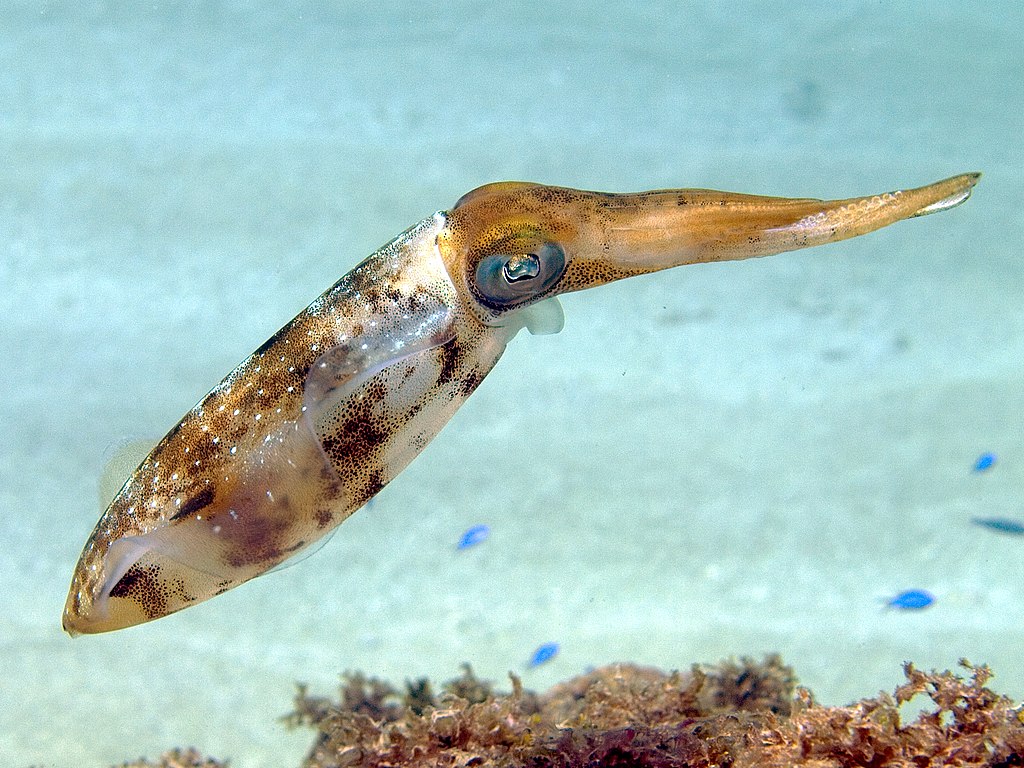- Squid are marine cephalopods known for their elongated bodies, tentacles, and ink sacs.
- They belong to the same family as octopuses and cuttlefish, collectively known as the “cephalopods.”
- Squid have a soft, muscular body enclosed in a mantle, which houses their organs.
- They are highly adapted for swimming, propelled by jet propulsion and the use of their fins.
- Squid have ten arms, which include two longer tentacles used for capturing prey.
- Their arms are lined with suction cups, which help them grasp and manipulate their food.
- Squid have excellent vision and can perceive polarized light, making them well-adapted to their deep-sea environment.
- Some squid species, such as the giant squid, can grow to impressive sizes, with bodies exceeding 40 feet (12 meters) in length.
- They are known for their ability to change color and patterns on their skin, allowing for camouflage and communication.
- Squid have a well-developed nervous system and are considered to be highly intelligent creatures.
- They are carnivorous and feed on a diet consisting primarily of fish, crustaceans, and other small marine animals.
- Squid have a beak-like mouth that they use to tear and consume their prey.
- They have a specialized organ called the “chromatophores” in their skin, which allow them to change color rapidly.
- Squid possess a unique defense mechanism known as ink release, where they expel a cloud of ink to confuse and distract predators.
- Some species of squid have bioluminescent properties, emitting light through specialized organs called photophores.
- Squid exhibit complex mating behaviors, with males often engaging in competitive displays and courtship rituals.
- They have separate sexes, with males using a specialized arm called the hectocotylus to transfer sperm to the female.
- Squid have a short lifespan, with most species living for only 1 to 2 years.
- They are capable of remarkable speeds in the water, with some species reaching speeds of up to 25 miles per hour (40 kilometers per hour).
- Squid communicate through a combination of visual displays, body postures, and color changes.
- They have a unique respiratory system, with water passing over their gills and oxygen being extracted for respiration.
- Squid are an important part of the marine food chain, serving as prey for larger predators such as whales, sharks, and dolphins.
- They have a streamlined body shape, allowing them to move through the water with minimal resistance.
- Squid are capable of regenerating lost or damaged limbs, a process known as autotomy.
- Some species of squid exhibit cannibalistic behavior, where larger individuals may prey on smaller squid.
- They have a well-developed ink sac, which produces a dark liquid used for defense and escaping from predators.
- Squid have three hearts: two branchial hearts that pump blood to the gills and one systemic heart that circulates blood throughout the body.
- They are known for their fast growth rates, with some species reaching maturity within a few months.
- Squid are highly adaptable and can adjust their behavior and physiology to changing environmental conditions.
- They are found in all major oceans around the world, inhabiting both shallow coastal waters and deep-sea regions.
- Squid have a streamlined body shape and powerful muscles, allowing them to generate strong propulsion through the water.
- They possess a unique ink sac, which produces a dark pigment that can be expelled as a defensive mechanism.
- Squid are capable of regenerating lost or damaged tentacles, which is important for their survival in the wild.
- They have a complex nervous system, allowing for advanced sensory perception and coordination.
- Squid exhibit different reproductive strategies, with some species laying large numbers of eggs while others give birth to live young.
- They are known to exhibit schooling behavior, gathering in large groups for safety and feeding purposes.
- Squid have a high metabolic rate, requiring them to consume a significant amount of food to sustain their energy needs.
- They have a remarkable ability to adjust their buoyancy by controlling the amount of gas in their internal chambers.
- Squid play an important role in the carbon cycle, as they consume and recycle organic matter in the ocean.
- They have a complex visual system, with large, sensitive eyes that allow for excellent depth perception and detection of prey.
- Squid have a thin, transparent layer of skin called the “pen,” which provides support and structure to their bodies.
- They exhibit fascinating courtship behaviors, including elaborate displays and changes in color and body posture.
- Squid have a unique ability to regenerate their ink sacs, allowing them to produce ink throughout their lives.
- They are capable of remarkable camouflage, blending seamlessly into their surroundings to avoid detection by predators.
- Squid are capable of rapid growth, with some species reaching full size within months of hatching.
- They have a unique reproductive strategy known as “semelparity,” where individuals reproduce once in their lifetime and then die shortly after.
- Squid play a vital role in ocean ecosystems as both predator and prey, contributing to the overall balance of marine life.
- They have a remarkable ability to squeeze through small openings and escape from tight spaces.
- Squid have a complex digestive system, including a muscular gizzard that helps break down food before it enters the stomach.
- They are fascinating creatures that continue to captivate scientists and researchers with their unique adaptations, behavior, and ecological importance in the marine ecosystem.
Facebook Comments


































